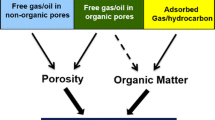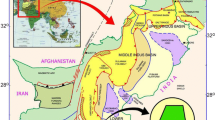Abstract
The accumulation of organic matter is the basis for gas generation and significantly affects the ultimate gas production in shale reservoirs. Estimation of organic enrichment using seismic data is essential for shale gas characterization. The commonly used correlations between elastic properties and organic matter content for a particular area are locally applicable but may not be workable for other zones. Herein, a general physics-based approach is proposed to predict organic enrichment in shales. An organic matter-matrix decoupling amplitude variation versus offset (AVO) formula is constructed to straightforwardly quantify seismic signatures of organic matter via an introduced organic matter-related factor (Mc). Then, the elastic impedance (EI) function is established from the decoupling AVO formula to compute Mc. The proposed EI inversion method is suitable for capturing organic enrichment, particularly in the case of inadequate petrophysics information for reliable evaluation of Mc using log data as a constraint in the inversion. The developed AVO formula and EI function regard the organic matter as solid pore-fillings, presenting a more reasonable model for organic shales. Numerical tests show that Mc exhibits enhanced sensitivity to organic matter content with respect to the regularly used elastic properties. The real data applications indicate that the estimated Mc agrees well with the gas production in horizontal development wells, suggesting that Mc is a good indicator of favorable gas areas. The proposed approach may have broader potential applications and can be extended to detect other fluids and solid-saturated hydrocarbon reservoirs such as shale oil, heavy oil, and gas hydrates.














Similar content being viewed by others
References
Aki K, Richards PG (2002) Quantitative Seismology. In: 2nd Sausalito: University Science Books
Alfred D, Vernik L (2013) A new petrophysical model for organic shales. Petrophys-SPWLA J Form Eval Reserv Descr 54:240–247
Bredesen K, Jensen EH, Johansen TA, Avseth P (2015) Seismic reservoir and source-rock analysis using inverse rock-physics modeling: a Norwegian Sea demonstration. Lead Edge 34:1350–1355
Carcione JM (2000) A model for seismic velocity and attenuation in petroleum source rocks. Geophysics 65:1080–1092
Carcione JM (2001) AVO effects of a hydrocarbon source-rock layer. Geophysics 66:419–427
Carcione JM, Gangi AF (2000) Gas generation and overpressure: effects on seismic attributes. Geophysics 65:1769–1779
Chen H, Pan X, Ji Y, Zhang G (2017) Bayesian Markov Chain Monte Carlo inversion for weak anisotropy parameters and fracture weaknesses using azimuthal elastic impedance. Geophys J Int 210:801–818
Chen H, Ji Y, Kristopher AI (2018) Estimation of modified fluid factor and dry fracture and dry fracture weaknesses using azimuthal elastic impedance. Geophysics 83:73–88
Chen F, Zong Z, Yang Y, Gu X (2022) Amplitude-variation-with-offset inversion using P- to S-wave velocity ratio and P-wave velocity. Geophysics 87:N63–N74
Chen F, Zong Z, Stovas A, Yin Y (2023) Wave reflection and transmission coefficients for layered transversely isotropic media with vertical symmetry axis under initial stress. Geophys J Int 233:1580–1595
Cheng G, Yin X, Zong Z (2019) Nonlinear elastic impedance inversion in the complex frequency domain based on an exact reflection coefficient. J Petrol Sci Eng 178:97–105
Ciz R, Shapiro SA (2007) Generalization of Gassmann equations for porous media saturated with a solid material. Geophysics 72:75–79
Connolly P (1999) Elastic impedance. Lead Edge 18:438–452
Grieser W, Bray J (2007) Identification of production potential in unconventional reservoir. In: SPE production and operations symposium. Production and Operations Symposium, 2007. Society of Petroleum Engineers. pp 243–248
Hashin Z, Shtrikman S (1963) A variational approach to the theory of the elastic behavior of multiphase materials. J Mech Phys Solids 11:127–140
Jia W, Zong Z, Lan T (2023) Elastic impedance inversion incorporating fusion initial model and kernel Fisher discriminant analysis approach. J Petrol Sci Eng 220:111235
Krief M, Garat J, Stellingwerff J, Ventre J (1990) A petrophysical interpretation using the velocities of P and S waves (full waveform sonic). Log Anal 31:355–369
Kuster GT, Toksoz MN (1974) Velocity and attenuation of seismic waves in two-phase media-1,2. Geophysics 39:587–618
Li J, Yin C, Liu X, Chen C, Wang M (2019) Robust pre-stack density inversion method for shale reservoir. Chin J Geophys 62:1861–1871 (in Chinese)
Lim U, Kabir N, Zhu D, Gibson R (2017) Inference of geomechanical properties of shales from AVO inversion based on the Zoeppritz equation. In: SEG Technical Program Expanded Abstracts 2017. Society of Exploration Geophysicists. Pp 728–732
Mavko G, Mukerji T, Dovrkin J (2009) The rock physics handbook: Tools for seismic analysis in porous media. Cambridge University Press, Cambridge
Ouadfeul S, Aliouane L (2016) Total organic carbon estimation in shale-gas reservoirs using seismic genetic inversion with an example from the Barnett Shale. Lead Edge 35:790–794
Pan X, Zhang G, Yin X (2018) Elastic impedance variation with angle and azimuth inversion for brittleness and fracture parameters in anisotropic elastic media. Surv Geophys 39:965–992
Pan X, Zhang P, Zhang G, Guo Z, Liu J (2021) Seismic characterization of fractured reservoirs with elastic impedance difference versus angle and azimuth: a low-frequency poroelasticity perspective. Geophysics 86:123–139
Passey QR, Bohacs KM, Esch WL, Klimentidis R, Sinha S (2010) From oil-prone source rock to gas-producing shale reservoir—geologic and petrophysical characterization of unconventional shale-gas reservoirs. Presented at the SPE, Paper 131350
Pinna G, Carcione JM, Poletto F (2011) Kerogen to oil conversion in source rocks. Pore -pressure build-up and effects on seismic velocities. J Appl Geophys 74:229–235
Russell BH, Gray D, Hampson DP (2011) Linearized AVO and poroelasticity. Geophysics 76:19–29
Sayers CM (2013) The effect of kerogen on the AVO response of organic-rich shales. Lead Edge 32:1514–1519
Sayers CM, Guo S, Silva J (2015) Sensitivity of the elastic anisotropy and seismic reflection amplitude of the Eagle Ford Shale to the presence of kerogen. Geophys Prospect 63:151–165
Schmoker JW (1979) Determination of organic content of Appalachian Devonian shales from formation-density logs. AAPG Bull 63:1504–1509
Sharma RK, Chopra S (2015) Estimation of density from seismic data without long offsets-a novel approach. In: 85th Annual International Meeting, SEG, Expanded Abstracts:2708–2110
Vernik L (1994) Hydrocarbon-generation-induced microcracking of source rocks. Geophysics 59:555–563
Vernik L, Liu X (1997) Velocity anisotropy in shales: a petrophysical study. Geophysics 62:521–532
Vernik L, Milovac J (2011) Rock physics of organic shales. Lead Edge 30:318–323
Whitcombe DN, Connolly PA, Reagan RL, Redshaw TC (2002) Extended elastic impedance for fluid and lithology prediction. Geophysics 67:63–67
Yilmaz Ö (2008) Seismic data analysis: Processing, inversion, and interpretation of seismic data. Society of Exploration Geophysicists, Tuslam, p 2021
Zhang W, Huang Z, Li X, Chen J, Guo X, Pan Y, Liu B (2020) Estimation of organic and inorganic porosity in shale by NMR method, insights from marine shales with different maturities. J Nat Gas Sci Eng 78:103290
Zhao L, Qin X, Han D, Geng J, Yang Z, Cao H (2016) Rock-physics modeling for the elastic properties of organic shale at different maturity stages. Geophysics 81:527–541
Zhao L, Qin X, Zhang J, Liu X, Han D, Geng J, Xiong YN (2018) An effective reservoir parameter for seismic characterization of organic shale reservoir. Surv Geophys 39:509–541
Zong Z, Sun Q (2022) Density stability estimation method from pre-stack seismic data. J Petrol Sci Eng 208:109373
Zong Z, Yin X, Wu G (2015) Geofluid discrimination incorporating poroelasticity and seismic reflection inversion. Surv Geophys 36:659–681
Acknowledgments
This work was supported by the National Natural Science Foundation of China (Grant No. 42074153 and 42274160). The authors thank the Editor in Chief Prof. Michael J. Rycroft and two anonymous reviewers for their constructive comments and suggestions.
Author information
Authors and Affiliations
Contributions
Conceptualization was contributed by ZG; methodology was contributed by ZG, XL; formal analysis was contributed by ZG, XL; investigation was contributed by ZG, XL; writing—review and editing, was contributed by ZG; validation was contributed by ZG; Software was contributed by XL; Visualization was contributed ZG, XL; writing—original draft, was contributed by ZG, XL; supervision was contributed by CL; resources were contributed by ZG, CL; data curation was contributed by XL.
Corresponding author
Ethics declarations
Conflict of interest
The authors declare that they have no known competing financial interests or personal relationships that could have appeared to influence the work reported in this paper.
Additional information
Publisher's Note
Springer Nature remains neutral with regard to jurisdictional claims in published maps and institutional affiliations.
Appendices
Appendix 1
Establishment of the Organic Matter–Matrix Decoupling AVO Formula
According to Russell et al. (2011), P- and S-wave velocities, VP and VS, can be expressed using Eqs. (1) and (2) as:
where ρ is the bulk density of shale.
Then, the two organic matter-related parameters in Eqs. (1) and (2) have the following forms:
where γdry represents the dry frame’s VP/VS ratio.
Aki and Richards (2002) proposed a linearized approximation of the PP-wave reflectivity as follows:
where θ is the average of the incidence and refraction angles; \(\overline{V}_{{\text{P}}}\), \(\overline{V}_{{\text{S}}}\), and \(\overline{\rho }\) are the averaged velocities and bulk density across the boundary, and the bar “–” will be omitted in the following expressions for simplicity; ∆ denotes the difference in according parameters across the interface; γsat represents the averaged VP/VS ratio of rocks.
Based on Russell et al. (2011), Eq. (20) can be rearranged as the following forms:
where the expression γsat = VP/VS is considered.
Treating γdry as a constant and applying the chain rule of the multivariable calculus to Eqs. (18) and (19) give:
Substituting Eqs. (18) and (19) into Eqs. (22) and (23) produces:
Equations (24) and (25) can be further rearranged as follows:
Substituting Eqs. (26) and (27) into Eq. (21), we have:
Using µdry = µsat –Mµ according to Eq. (19) and setting µ = µsat by neglecting the subscript “sat” for simplicity, we further rearrange Eq. (28)as:
Dividing Eqs. (18) and (19) by ρVP2 on both sides gives:
Substituting Eq. (31) into Eq. (30) produces:
Equation (32) can be expressed considering µdry = µsat–Mµ = ρVs2 – Mµ:
Equation (33) can be further rearranged as follows:
Substituting Eq. (34) into Eq. (29) produces:
Equation (35) is further rearranged using ρVP2 = γsat2ρVS2 = γsat2μ:
Introducing the factor N = Mμ/Mk can rearrange Eq. (36) to give the ultimate form of the organic matter-matrix decoupling formula:
For fluid saturation, we have Mµ = 0 due to µdry = µsat in Eq. (19). Therefore, the factor N = Mμ/Mk = 0 in this case, making Eq. (37) expressed as:
Equation (38) has the same form of the formula proposed by Russell et al. (2011), with the term ΔMk /Mk equivalent to the fluid term Δf /f in their paper.
Appendix 2
EI Inversion Based on the Organic Matter-Matrix Decoupling AVO Formula
According to the theory of Connolly (1999), the PP-wave reflection coefficient is expressed by EI:
Substituting Eq. (39) into Eq. (7) gives:
Using the relationship \(\frac{\Delta x}{x} \approx \Delta \ln x\) produces:
By denoting the weighting coefficients in Eq. (41) as follows:
Equation (42) can be simplified in the following form:
The EI-based formula is obtained by integrating and exponentiating both sides of Eq. (43):
According to Whitcombe et al. (2002), Eq. (44) should be properly scaled for directly comparing EI values at different incidence angles:
where Mc0, µ0, and ρ0 represent the averaged values of Mc, µ, and ρ calculated from log data for the target depth interval. The normalization factor A corresponds to EI(0°) in Eq. (44), which has the expression:
Taking the log function on both sides of Eq. (45) gives:
Rights and permissions
Springer Nature or its licensor (e.g. a society or other partner) holds exclusive rights to this article under a publishing agreement with the author(s) or other rightsholder(s); author self-archiving of the accepted manuscript version of this article is solely governed by the terms of such publishing agreement and applicable law.
About this article
Cite this article
Guo, Z., Lv, X. & Liu, C. Estimating Organic Enrichment in Shale Gas Reservoirs Using Elastic Impedance Inversion Based on an Organic Matter−Matrix Decoupling Method. Surv Geophys 44, 1985–2009 (2023). https://doi.org/10.1007/s10712-023-09789-6
Received:
Accepted:
Published:
Issue Date:
DOI: https://doi.org/10.1007/s10712-023-09789-6




